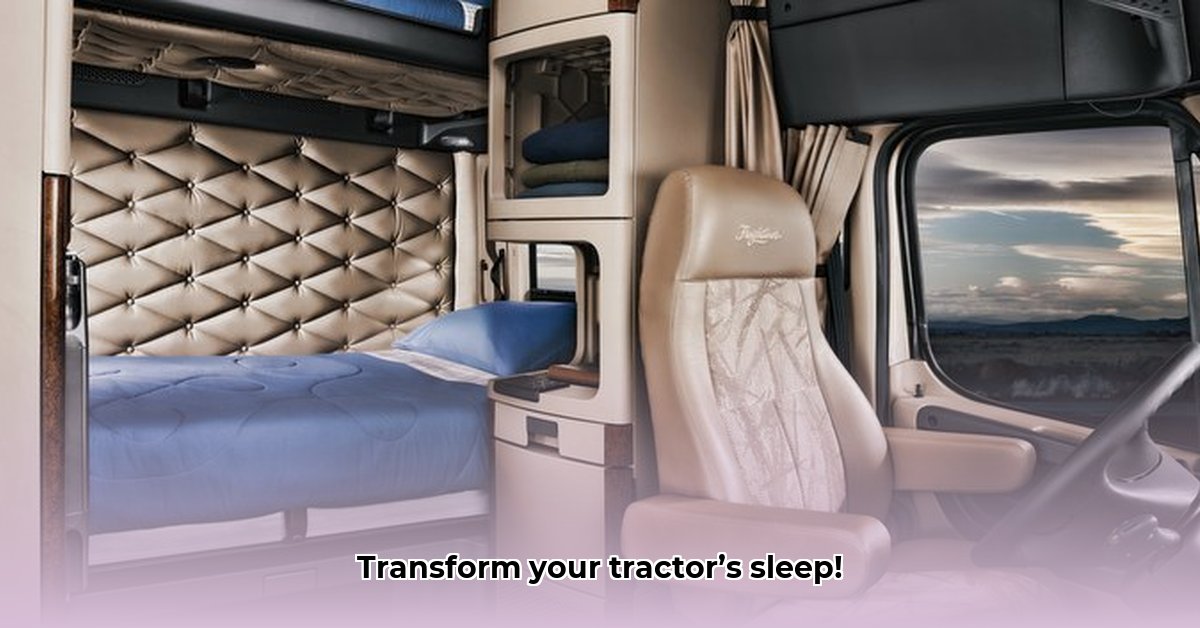
The world of long-haul trucking is undergoing a transformation, and at the heart of this change is the humble sleeper cab. No longer simply a place to rest, the modern tractor sleeper is evolving into a mobile haven, a testament to the growing demand for improved driver comfort and efficiency. This article delves into the burgeoning market for custom tractor sleepers, exploring the key players, innovative technologies, and the challenges and opportunities that lie ahead. For enhanced driver comfort, consider driver seat upgrades.
The Rise of the Custom Sleeper Cab
The market for customized tractor sleepers is experiencing explosive growth. Why the surge in popularity? The answer is multifaceted. Drivers are demanding better living conditions on the road, seeking comforts that rival their homes. Simultaneously, fuel efficiency is becoming a critical concern for trucking companies. This confluence of factors—driver well-being and operational efficiency—is fueling the demand for enhanced sleeper cabs. Companies like Bolt Custom Trucks and Legacy Sleepers are leading the charge, creating sleepers that are not just places to sleep, but mobile living quarters. But is the market growth sustainable? Are there hidden risks? Let's explore.
Meet the Big Players: Bolt and Legacy
Bolt Custom Trucks and Legacy Sleepers represent two significant players in this dynamic market. Both prioritize driver comfort and fuel efficiency, recognizing the crucial link between a well-rested driver and increased productivity, and improved safety. Though obtaining precise pricing and manufacturing data proved challenging, highlighting a lack of industry transparency, their commitment to innovation is evident. Both companies focus on improving driver experience, which ultimately translates to greater profitability for trucking companies. Do all big players share this commitment to driver well-being?
Technology Takes the Wheel: Innovation in Sleeper Design
Modern tractor sleepers are integrating cutting-edge technology. Innovative materials and aerodynamic designs are key to boosting fuel economy – a direct path to cost savings for trucking companies. Smart climate control systems automatically adjust temperatures, and advanced infotainment systems aim to keep drivers connected, alert, and comfortable, reducing driver fatigue and enhancing road safety. This isn’t just about luxury; it's about enhancing driver well-being and operational efficiency. But what about the impact on driver experience?
Life on the Road: A Driver's Perspective
The impact of these improvements is profound. Imagine a comfortable bed, a hot shower, and even a refrigerator—transforming the long-haul trucking experience from grueling to manageable, even enjoyable. These are not merely physical comforts; they boost morale and significantly impact driver health and well-being, directly contributing to improved road safety. However, the human element needs more focus with more driver testimonials and case studies to understand the full impact. How does a improved sleeper cab impact driver retention and recruitment in the industry?
Challenges and Opportunities Ahead: The Road to Success
The path ahead isn't without obstacles. Supply chain disruptions, intense competition, and regulatory changes present significant headwinds. However, the long-term outlook remains positive. Mitigation strategies include diversified sourcing, cultivating strong supplier relationships, optimizing manufacturing processes, and investing in targeted marketing and exceptional customer service. What steps can further improve the long-term sustainability of this market?
Actionable Steps: Navigating the Future
To ensure sustained growth and market dominance, strategic action is required across multiple stakeholder groups:
Truck Manufacturers (OEMs): Should collaborate more extensively with custom sleeper builders to enhance OEM integration and streamline production processes. Long-term, investment in lightweight, sustainable materials and advanced manufacturing techniques is crucial.
Custom Sleeper Companies: Need to expand production capacity, improve supply chain resilience, and invest in robust after-sales support and maintenance programs. Strategic marketing and driver feedback are also vital.
Truck Drivers: Should actively provide feedback, explore financing options allowing them to upgrade, and engage in industry dialogues to advocate for improved safety and well-being standards.
Regulatory Bodies: Must ensure consistent enforcement of safety and emission regulations, while prioritizing driver welfare standards. Incentivizing the adoption of green and efficient designs through appropriate regulatory frameworks is crucial.
Navigating the Risks: A Realistic Assessment
Several risk factors warrant careful consideration:
Supply Chain Disruptions: The likelihood is high, with a significant potential negative impact. Mitigation strategies include diversified sourcing and strong supplier relationships.
Increased Materials Costs: Similarly likely, with high impact. Mitigation involves process optimization and exploring cost-effective materials.
Intense Market Competition: High likelihood, but medium impact. Differentiation through unique selling points and superior customer service is essential.
Regulatory Changes: Possible but with a high potential impact. Consistent monitoring of regulatory developments and proactive adaptation are critical.
Skilled Labor Shortages: A potential risk with a medium impact, mitigation strategies include investment in training programs, competitive compensation, and exploration of automation.
The future of the custom tractor sleeper market is bright. However, sustained success hinges on collaboration among all stakeholders—prioritizing driver comfort, fuel efficiency, and proactively addressing emerging challenges. This isn’t just about improving cabs; it’s about shaping a better future for long-haul truckers and the entire trucking industry.